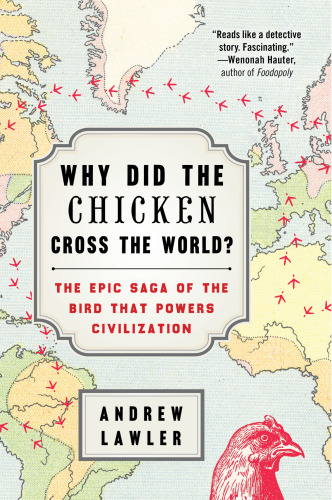
Why Did the Chicken Cross the World?
The Epic Saga of the Bird That Powers Civilization
کتاب های مرتبط
- اطلاعات
- نقد و بررسی
- دیدگاه کاربران
نقد و بررسی

September 22, 2014
In his first book, journalist Lawler offers an encyclopedic examination of the chicken’s ever-growing and complex role in societies and civilization, tracing the bird’s migration across countries and cultures, from its role as a “rare and royal bird” in ancient Egypt and Mesopotamia to its current status as the product of industrial farming, which can be traced back to the Chicken of Tomorrow project launched in the U.S. at the end of WWII. The chicken plays many roles, ranging from mere foodstuff to a symbol of light and resurrection in some religions, as well as its key role in creating the flu vaccine that has helped millions. The bleaker sides to this narrative are handled bluntly—specifically, Lawler covers the intricacies and significance of cockfighting in certain cultures and provides an unflinching portrayal of the conditions in which commercial chickens are raised. Throughout, he maintains an objective stance. Readers are sure to come away with a deeper understanding of—and greater appreciation for—an animal that’s considered commonplace. Agent: Ethan Bassoff, Lippincott Massie McQuilkin.

November 15, 2014
Lawler (contributing editor, Archeology) sets out to explore the historical, cultural, sociological, and anthropological origins and development of the chicken, both in Eastern and Western societies. He explores everything from frontiers in poultry science to the enduring popularity of cockfighting in several places around the world, and most important how the bird evolved from a symbol of prosperity to one of the cheapest and most ubiquitous sources of nutrition. Lawler's journey takes him all over the globe and many facets of the bird's history are covered; the narrative flows seamlessly among unique aspects, such as Darwinian history and contemporary coverage of the underside of Filipino society. This title is the strongest when the focus is on the scientific angle of poultry science but stays relevant and compelling when exploring other areas. A multifaceted study of the development of poultry may not, at first glance, present itself as a gripping read for the general reader; however, this work succeeds by utilizing cultural context in addition to strong and relevant prose. VERDICT Recommended for readers of popular nonfiction as well as those with a specific interest in accessible scientific and anthropological studies.--Ben Neal, Richland Lib., Columbia, SC
Copyright 2014 Library Journal, LLC Used with permission.

Starred review from November 15, 2014
The chicken, like all domesticated animals, was bred from a wild ancestor: the red jungle fowl, a shy pheasant so distrustful of humans that it seems a very unlikely candidate for domestication. Science-writer Lawler begins this absorbing survey of one of our most important cross-species relationships with a look at the endangered jungle fowl, and from here, he tracks the chicken's journey as it slowly spreads throughout the world. Lawler speaks with numerous archaeologists, scientists, and farmers to tease out what we've learned about when the chicken was domesticated, how it was traded among ancient civilizations, and how it came to symbolize so many attributes in both religion and daily life. The chicken's place in medicine, both ancient and modern; the major role cockfighting had in the spread of the bird; and the development of the Fancy (or hen fever ) in England and its implications for Charles Darwin's ideas about natural selection are all embraced in Lawler's witty, conversational book. Finally, the emergence of the mass production of chickens and eggs in modern factory farms is examined for both its role in the rise of more universal consumption of cheap protein and as fodder for the animal-rights movement. Readers will get to know the bird behind the McNugget.(Reprinted with permission of Booklist, copyright 2014, American Library Association.)

























دیدگاه کاربران